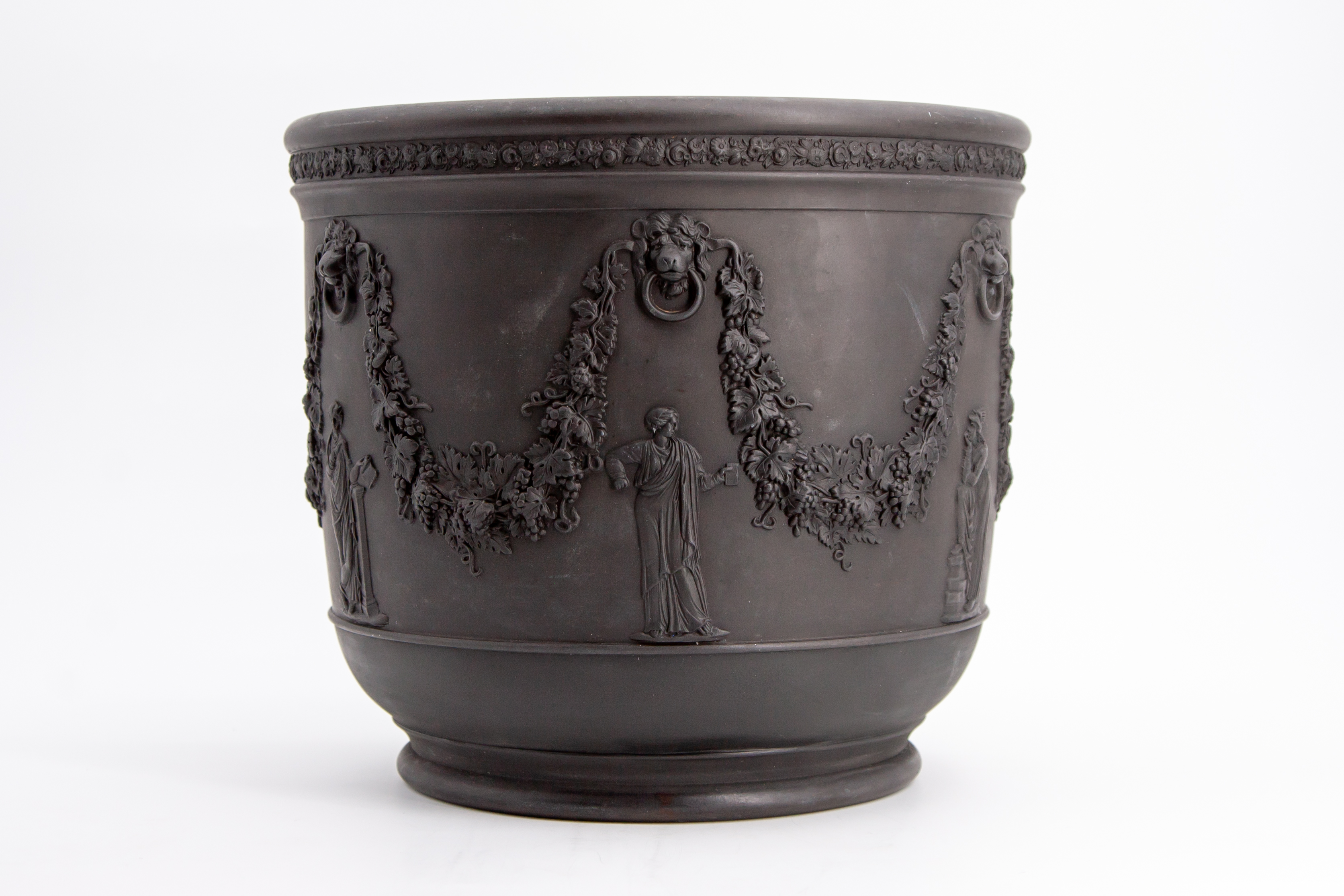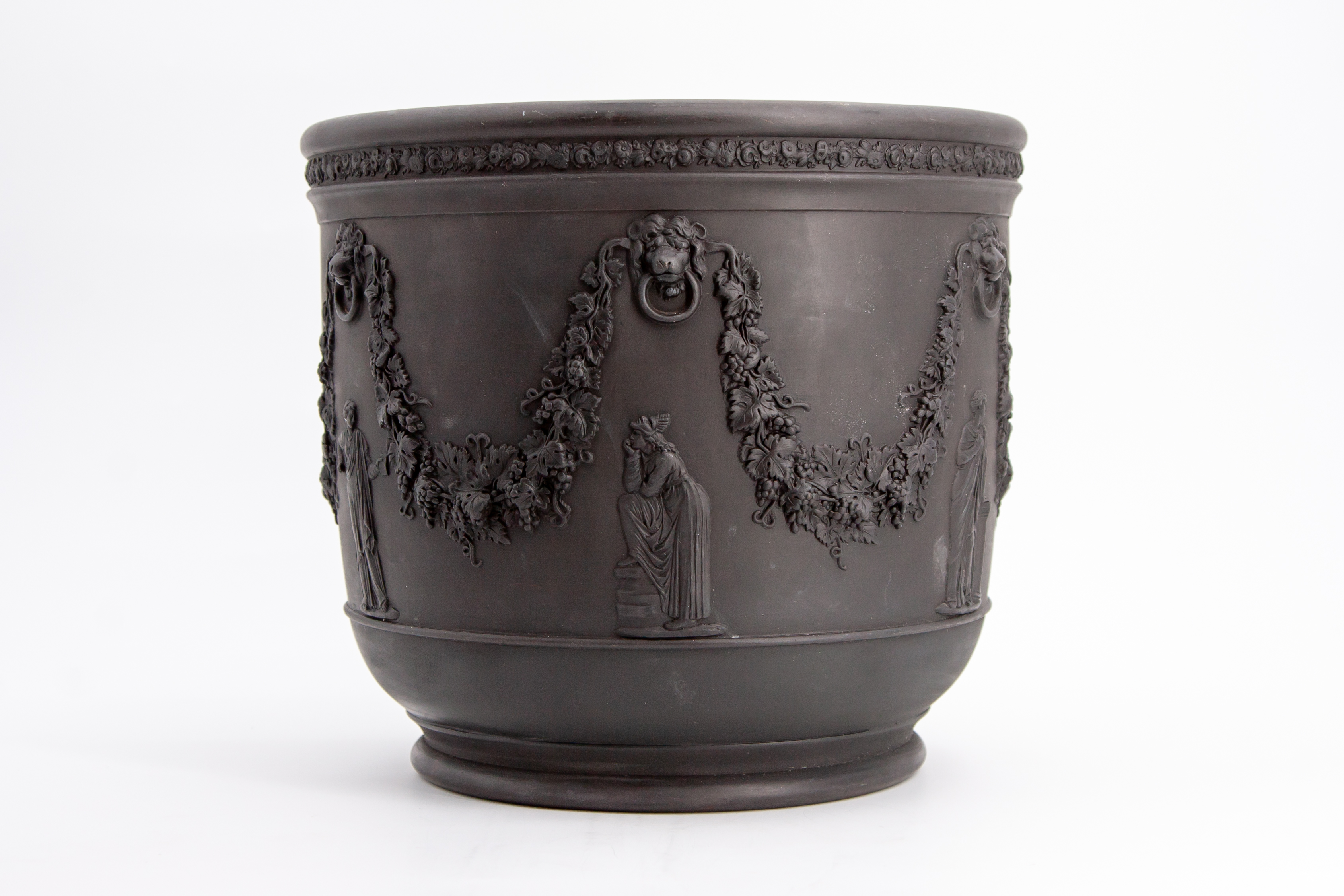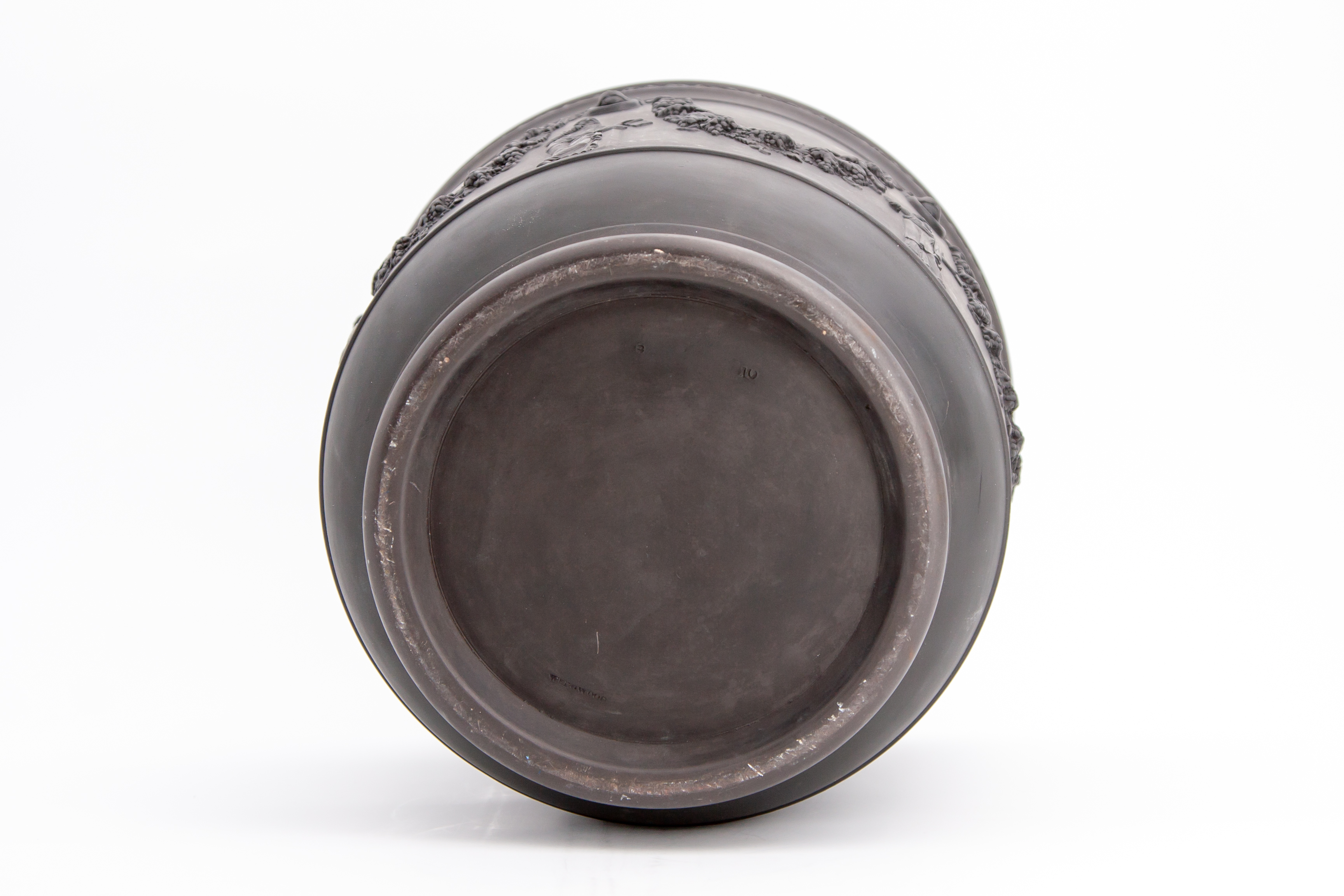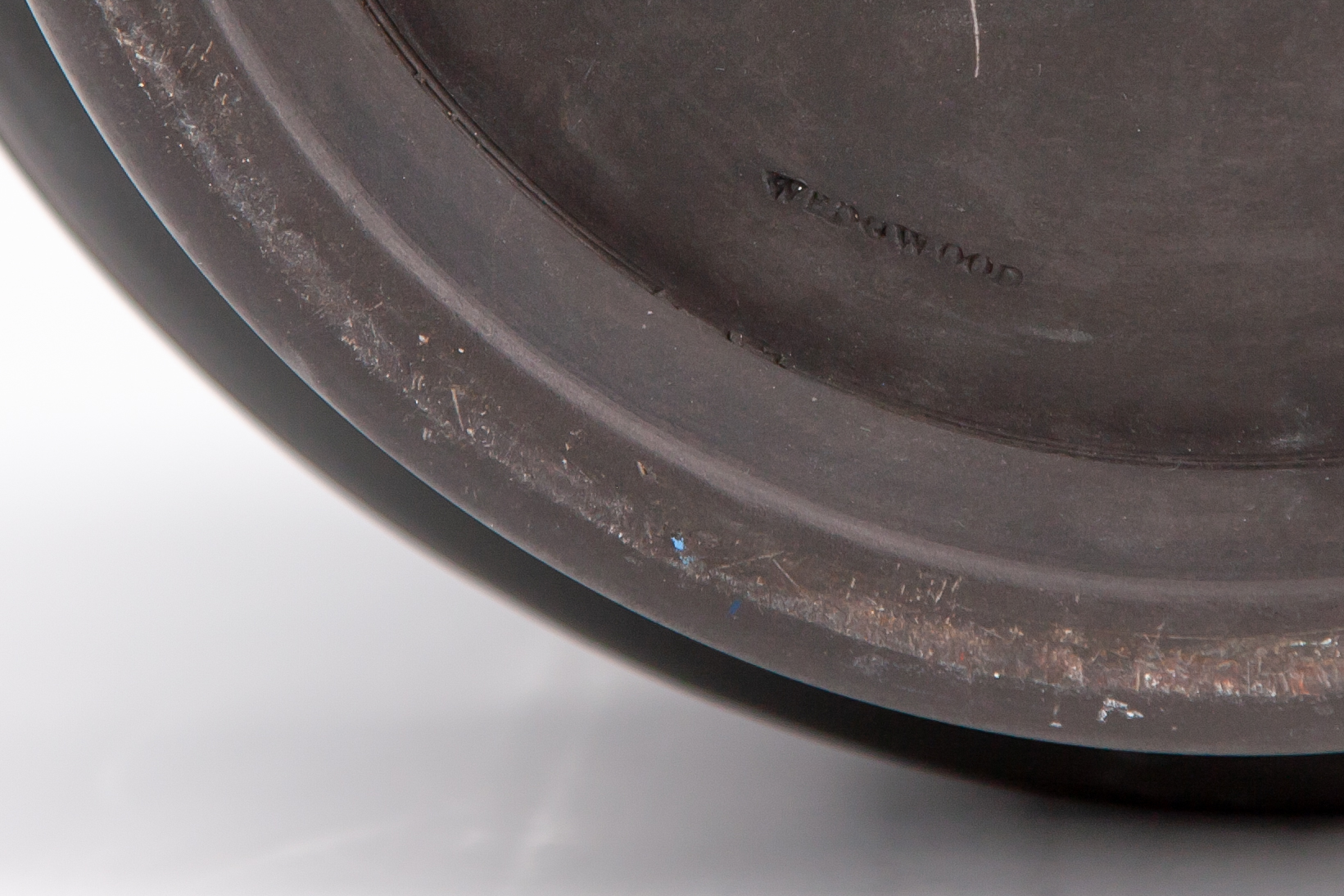Upon their introduction to the market, black basalt ceramics became instantly popular for their connection to Antiquity. During the 18th century, archaeological excavations by classicists such as Johann Joachim Winckelmann and Sir William Hamilton unearthed ancient pottery, bronze, and marble objects which were sources of inspiration to English designers such as Josiah Wedgwood. Black basalt wares, such as this early 19th-century jardiniere, served as the perfect medium to bring a Classic aesthetic to an English market.
Upon their introduction to the market, black basalt ceramics became instantly popular for their connection to Antiquity. During the 18th century, archaeological excavations by classicists such as Johann Joachim Winckelmann and Sir William Hamilton unearthed ancient pottery, bronze, and marble objects which were sources of inspiration to English designers such as Josiah Wedgwood. Black basalt wares, such as this early 19th-century jardiniere, served as the perfect medium to bring a Classic aesthetic to an English market.
Essay
During the latter half of the eighteenth century, the Neoclassical style developed in England. This style, present in everything from architecture to decorative arts, was largely influenced by the English rediscovery of Antiquity through the Grand Tour. It was during this period that Josiah Wedgwood developed his celebrated black stonewares, coining them “Black Basaltes” in 1768.
Staffordshire potteries had been making black ceramic vessels throughout the eighteenth century using reddish brown clay that was fired around 1,200 degrees Celsius. Potters would add a coloring agent known as “carr” derived from iron residue in mine drainage. During the firing process, the clay would turn black. They termed their wares ‘Egyptian black.’ The 1760s saw the successful experimentation of purely black wares. Innovators such as Josiah Wedgwood added manganese to the clay to create an even richer black color.
Black basalt pottery was created during the height of the Grand Tour. Beginning in the seventeenth century and lasting through the nineteenth century, the Grand Tour took the English into the Continent to experience the seat of Western culture in the Italian peninsula. Tourists often had an education in the Classics, which made travel to ancient sites such as Rome and Naples popular. These Classical sites welcomed travelers who in turn picked up inspiration from Antique architecture and artifacts, then brought it back to England to incorporate into new designs. The Antique style was disseminated through publications and catalogs, most notably Sir William Hamilton’s 1766 catalog entitled Collection of Etruscan, Greek and Roman antiquities. Other seminal catalogs of Antiquity included Bernard de Montfaucon’s L’Antiquite Expliquee et representee en figures (1722) and Count Caylus’s Receuil d’Antiquites Egyptiennes Etrusques, Greques et Romaines (1761). The major British designers owned their own copies of these texts, including Josiah Wedgwood.
Wedgwood saw the potential of “Black Basaltes” because of their connection to Italy. Indeed, the very name “black basalt” is connected with the Italian peninsula through its reference to volcanic rock: “The choice of the name ‘Black Basalt’ for this type of ceramic was no doubt influenced by the so-called basalt controversy over the disputed volcanic origins of the black basalt rock” (Jenkins & Sloan, 1996: 182). Southern Italy was home to the famous Mount Vesuvius, which was a popular Grand Tour destination for classicists and natural historians alike. Classicists were interested in the newly unearthed artifacts at Pompeii and Herculaneum, which had a marked influence on our jardiniere, discussed in detail below. Natural historians and amateur scientists were interested in the Neapolitan environment, which experienced six volcanic eruptions throughout the eighteenth century. Possession of this jardiniere would show the worldliness of its owner through its implicit reference to both Antiquity and to Italy. Diana Edwards explains that black basalt was the perfect medium to express taste:
The technology of the basalt fabric was in the incubus; the past, forged by a social elite anxious to protect its authority by reference to Antiquity, provided the iconography, and the rise of a prospering middle class provided the market. The prospering of all classes clamoured for urns, cassolettes and garnitures of vases for chimney-pieces (Edwards 1994: 34).
Not only was black basalt technologically innovative through its production methods, which utilized engine-turned lathes, but the medium also employed Neoclassicism as a reference to an Antique past which was vital to establishing a social hierarchy. The Neoclassical style allowed the British to display Grand Tour aesthetics in their homes. Nicola Pickering asserts that the Neoclassical style was “frequently employed for domestic use in public rooms, those intended to be seen and admired, used for leisure and entertainment. The Neoclassical style could imply that the patron had European connections, education and refinement, reflecting their connoisseurship and appreciation of ancient history” (Pickering 2018: 74). This jardiniere was likely displayed in a public place in the home and demonstrated the wealthy status of its owner by connecting him to an aristocratic tradition of traveling throughout the Continent. The owner of this jardiniere would have been expressing cosmopolitanism as well as historicism: the means to travel abroad, a knowledge and appreciation of the Classical world, and taste in his possession of an object in the new style of Neoclassicism.
The jardiniere features many Neoclassical details which fit the gout etrusque style of that period. The gout etrusque “[dedicated] itself to a more scientific study of antiquity and to forge a revised image of it,” and “relied upon naturalistic ornamental motifs and chimerical figural inventions, arranged in mirror image around a central axis” (Ottomeyer 2004: 19-20). The decorative elements, made with a mold and then attached to the ceramic body, include lion mask ring handles and garland swags of grape vines that are draped around the vessel. The scene on the body shows Apollo and five Muses, a design attributed to John Flaxman and inspired by or even possibly copied directly from Sir Hamilton’s catalog. It is interesting to note that the jardiniere is not an accurate representation of the Classical subject: only five of the nine Muses are depicted. The four Muses’ omission demonstrates the Neoclassical spirit of adapting Antique designs for contemporary aesthetic needs. Wedgwood in particular worked in this way. A Jasperware Plaque by John Flaxman in the Brooklyn Museum features a similar Apollo and the Muses scene, but shows all nine Muses. This demonstrates the Wedgwood factory’s adeptness for manufacturing. Figures could be selected by the designer to fit his vision of a particular object. The decorations’ interchangeability enabled the factory to quickly produce items that were unique and of high-quality at little expense and effort.
This jardiniere, an homage to Western culture with references to Antiquity, was at the height of fashion when it was introduced to the British market in the late eighteenth century. As the provenance of this jardiniere is unknown, we can only speculate about the previous owners, who were likely upper-middle class (black basalt, while not inexpensive, was more affordable than silver, which was the other popular medium for Neoclassical wares). Regardless of the economic status of its owners, however, it is clear that the jardiniere was used to convey a social elitism. The technologically innovative new medium of black basalt, the Classical iconography, and the connection to the aristocratic Grand Tour all worked to turn this jardiniere into a symbol of status, taste, and refinement for its owner.
BT
Condition
Excellent. Some areas of light wear.
For a detailed condition report, please contact us.
References
Edwards, Diana. Black Basalt: Wedgwood and Contemporary Manufacturers. Woodbridge, Suffolk: Antique Collectors’ Club, 1994.
Jenkins, Ian Jenkins and Kim Sloan. Vases and Volcanoes: Sir William Hamilton and His Collection. London: British Museum Press, 1996.
Ottomeyer, Hans. “The Metamorphosis of the Neoclassical Vase.” In Vasemania: Neoclassical Form and Ornament in Europe, edited by Heather Jane McCormick and Hans Ottomeyer, 15-30. New York: The Bard Graduate Center, 2004.
Pickering, Nicola. “‘The beautiful spirit of antiquity’: Pompeii and Herculaneum as inspiration for Neoclassical interior schemes in eighteenth-century Europe.” In Winckelman and Curiosity in the 18th-century Gentleman’s Library, edited by Katherine Harloe, Cristina Neagu, and Amy C. Smith, 70-89. Oxford: Christ Church Library, 2018.
Cited Works
During the latter half of the eighteenth century, the Neoclassical style developed in England. This style, present in everything from architecture to decorative arts, was largely influenced by the English rediscovery of Antiquity through the Grand Tour. It was during this period that Josiah Wedgwood developed his celebrated black stonewares, coining them “Black Basaltes” in 1768.
Staffordshire potteries had been making black ceramic vessels throughout the eighteenth century using reddish brown clay that was fired around 1,200 degrees Celsius. Potters would add a coloring agent known as “carr” derived from iron residue in mine drainage. During the firing process, the clay would turn black. They termed their wares ‘Egyptian black.’ The 1760s saw the successful experimentation of purely black wares. Innovators such as Josiah Wedgwood added manganese to the clay to create an even richer black color.
Black basalt pottery was created during the height of the Grand Tour. Beginning in the seventeenth century and lasting through the nineteenth century, the Grand Tour took the English into the Continent to experience the seat of Western culture in the Italian peninsula. Tourists often had an education in the Classics, which made travel to ancient sites such as Rome and Naples popular. These Classical sites welcomed travelers who in turn picked up inspiration from Antique architecture and artifacts, then brought it back to England to incorporate into new designs. The Antique style was disseminated through publications and catalogs, most notably Sir William Hamilton’s 1766 catalog entitled Collection of Etruscan, Greek and Roman antiquities. Other seminal catalogs of Antiquity included Bernard de Montfaucon’s L’Antiquite Expliquee et representee en figures (1722) and Count Caylus’s Receuil d’Antiquites Egyptiennes Etrusques, Greques et Romaines (1761). The major British designers owned their own copies of these texts, including Josiah Wedgwood.
Wedgwood saw the potential of “Black Basaltes” because of their connection to Italy. Indeed, the very name “black basalt” is connected with the Italian peninsula through its reference to volcanic rock: “The choice of the name ‘Black Basalt’ for this type of ceramic was no doubt influenced by the so-called basalt controversy over the disputed volcanic origins of the black basalt rock” (Jenkins & Sloan, 1996: 182). Southern Italy was home to the famous Mount Vesuvius, which was a popular Grand Tour destination for classicists and natural historians alike. Classicists were interested in the newly unearthed artifacts at Pompeii and Herculaneum, which had a marked influence on our jardiniere, discussed in detail below. Natural historians and amateur scientists were interested in the Neapolitan environment, which experienced six volcanic eruptions throughout the eighteenth century. Possession of this jardiniere would show the worldliness of its owner through its implicit reference to both Antiquity and to Italy. Diana Edwards explains that black basalt was the perfect medium to express taste:
The technology of the basalt fabric was in the incubus; the past, forged by a social elite anxious to protect its authority by reference to Antiquity, provided the iconography, and the rise of a prospering middle class provided the market. The prospering of all classes clamoured for urns, cassolettes and garnitures of vases for chimney-pieces (Edwards 1994: 34).
Not only was black basalt technologically innovative through its production methods, which utilized engine-turned lathes, but the medium also employed Neoclassicism as a reference to an Antique past which was vital to establishing a social hierarchy. The Neoclassical style allowed the British to display Grand Tour aesthetics in their homes. Nicola Pickering asserts that the Neoclassical style was “frequently employed for domestic use in public rooms, those intended to be seen and admired, used for leisure and entertainment. The Neoclassical style could imply that the patron had European connections, education and refinement, reflecting their connoisseurship and appreciation of ancient history” (Pickering 2018: 74). This jardiniere was likely displayed in a public place in the home and demonstrated the wealthy status of its owner by connecting him to an aristocratic tradition of traveling throughout the Continent. The owner of this jardiniere would have been expressing cosmopolitanism as well as historicism: the means to travel abroad, a knowledge and appreciation of the Classical world, and taste in his possession of an object in the new style of Neoclassicism.
The jardiniere features many Neoclassical details which fit the gout etrusque style of that period. The gout etrusque “[dedicated] itself to a more scientific study of antiquity and to forge a revised image of it,” and “relied upon naturalistic ornamental motifs and chimerical figural inventions, arranged in mirror image around a central axis” (Ottomeyer 2004: 19-20). The decorative elements, made with a mold and then attached to the ceramic body, include lion mask ring handles and garland swags of grape vines that are draped around the vessel. The scene on the body shows Apollo and five Muses, a design attributed to John Flaxman and inspired by or even possibly copied directly from Sir Hamilton’s catalog. It is interesting to note that the jardiniere is not an accurate representation of the Classical subject: only five of the nine Muses are depicted. The four Muses’ omission demonstrates the Neoclassical spirit of adapting Antique designs for contemporary aesthetic needs. Wedgwood in particular worked in this way. A Jasperware Plaque by John Flaxman in the Brooklyn Museum features a similar Apollo and the Muses scene, but shows all nine Muses. This demonstrates the Wedgwood factory’s adeptness for manufacturing. Figures could be selected by the designer to fit his vision of a particular object. The decorations’ interchangeability enabled the factory to quickly produce items that were unique and of high-quality at little expense and effort.
This jardiniere, an homage to Western culture with references to Antiquity, was at the height of fashion when it was introduced to the British market in the late eighteenth century. As the provenance of this jardiniere is unknown, we can only speculate about the previous owners, who were likely upper-middle class (black basalt, while not inexpensive, was more affordable than silver, which was the other popular medium for Neoclassical wares). Regardless of the economic status of its owners, however, it is clear that the jardiniere was used to convey a social elitism. The technologically innovative new medium of black basalt, the Classical iconography, and the connection to the aristocratic Grand Tour all worked to turn this jardiniere into a symbol of status, taste, and refinement for its owner.
BT
Excellent. Some areas of light wear.
For a detailed condition report, please contact us.
Edwards, Diana. Black Basalt: Wedgwood and Contemporary Manufacturers. Woodbridge, Suffolk: Antique Collectors’ Club, 1994.
Jenkins, Ian Jenkins and Kim Sloan. Vases and Volcanoes: Sir William Hamilton and His Collection. London: British Museum Press, 1996.
Ottomeyer, Hans. “The Metamorphosis of the Neoclassical Vase.” In Vasemania: Neoclassical Form and Ornament in Europe, edited by Heather Jane McCormick and Hans Ottomeyer, 15-30. New York: The Bard Graduate Center, 2004.
Pickering, Nicola. “‘The beautiful spirit of antiquity’: Pompeii and Herculaneum as inspiration for Neoclassical interior schemes in eighteenth-century Europe.” In Winckelman and Curiosity in the 18th-century Gentleman’s Library, edited by Katherine Harloe, Cristina Neagu, and Amy C. Smith, 70-89. Oxford: Christ Church Library, 2018.
This item ships free to the continental US, and globally for a flat-rate fee of $150.
All objects are packed with utmost care by our team of expert fine art shippers. All items are shipped with parcel insurance.
For more information on our shipping policies, please visit our FAQ Page.












